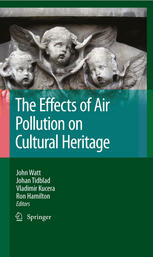

Most ebook files are in PDF format, so you can easily read them using various software such as Foxit Reader or directly on the Google Chrome browser.
Some ebook files are released by publishers in other formats such as .awz, .mobi, .epub, .fb2, etc. You may need to install specific software to read these formats on mobile/PC, such as Calibre.
Please read the tutorial at this link: https://ebookbell.com/faq
We offer FREE conversion to the popular formats you request; however, this may take some time. Therefore, right after payment, please email us, and we will try to provide the service as quickly as possible.
For some exceptional file formats or broken links (if any), please refrain from opening any disputes. Instead, email us first, and we will try to assist within a maximum of 6 hours.
EbookBell Team

0.0
0 reviewsThis book examines the impact of air pollution on cultural heritage materials, which is a serious concern because it can lead to loss of important parts of our history and culture. Damage includes corrosion, bio-degradation and soiling. In recent years, there have been major changes in both the sources and amounts of emissions of air pollution that have altered the rate and extent of building damage. The book reviews the sources of the air pollutants responsible for building damage and the mechanisms involved. Studies investigating the relationships between pollution concentration (dose) and the resulting damage (response) are described and the latest research findings for dose-response functions presented.
Trends in pollutant emissions, ambient concentrations and changes in building damage over time are discussed and future predictions presented.. Procedures for estimating the economic implications are described and the consequences are discussed in detail, because economic factors are important for reaching policy and management decisions at local, national and international scales. An important part of the economic evaluation relies on having reliable estimates of theactual amounts of material that need to be considered - the stock at risk. This estimation is difficult for heritage materials, since the buildings and monuments involved are very varied in size, shape, age and composition. The most up to date studies are presented, with a number of case studies to show how this subject may be approached.
Damage to cultural heritage buildings is an important effect of air pollution, which needs to be considered as current air quality standards, largely based on health effects, are revised. The factors which will need to be brought into the assessment, including potential ways to address the fact that there is no general consensus on what might be considered a tolerable or acceptable rate, are presented. Finally, a range of possible strategies and methods for conservation and maintenance, as required by building managers, is described and a number of case studies presented.
This book combines the results of recent research with practical information and provides an important reference manual for researchers, policy makers, economists and historic building managers working in the field of cultural heritage protection.